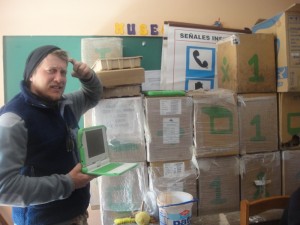One Laptop Per Child in Peru
July 4, 2011
Last week, while on a visit to Pampacoral to check on the status of their Greenhouse, I had the opportunity to meet with the school director, Freddie. One wall of his office was pilled from floor to ceiling with large brown boxes. I looked closer and realized it was nearly 150 little green and white laptops. The laptops come from the international recognized One Laptop per Child program. The program, of which Peru is one of the largest participants, aims to improve levels of education in impoverished communities through the distribution of cheap, durable, laptops to school aged children.
My initial reaction to seeing all those boxes was one of skepticism, as I first became aware of Peru’s involvement with this program last year in Beryl Levenger’s Program Evaluation Class. One of the primary criticisms against the programs is that it proposes a solution (laptops) before clearly defining the problem they are trying to solve (poverty? Lack of education? Lack of computer literacy?). The Peruvian Government, however, has thrown caution to the wind purchasing large numbers of these laptops and I was interested to see first hand their effect.
When I spoke with Freddie, he told me that the children were using the laptops frequently and loved them, but when asked what they were used for, he said they were used mostly used for games and free writing exercises. Freddie went on to say that the laptops did not have programs for math, science, or English loaded onto them. I had a sense that, while these laptops were fun for the kids, their role as a learning tool was limited.
Seeing this program in person highlighted for me one of the major challenges of development, there are no one size fits all solution. Many people are looking for magic bullets that will solve all the problems of the global south, either through new technologies or through various innovative economic models; for success is something that is measured on a much smaller scale.
As I walked out of Freddie’s office I saw about 40-50 little kids running to the school cafeteria with their bowls in hand, and I was reminded what brought us to Pampacoral, a community with a food security problem. That day the children ate Swiss chard grown from the Greenhouse. While we haven’t solved this problem, kids eating more vegetables was our small success for the trip, and that is a step in the right direction. ~ Brian
Entry Filed under: Agriculture Projects. Posted in Agriculture Projects Tags: Brian, Education, Technology Fail.



7 Comments Add your own
Tom | July 7th, 2011 at 1:19 am
To be honest, when I first heard about this initiative, I was skeptical, and your experience here only serves to build on that skepticism. I think money can be used in better ways than providing laptops.
amy mcgill | July 7th, 2011 at 3:20 pm
Hi, Brian — I share your concerns about the “one laptop” program — or any solution in search of a problem — but one of my favorite TED talks offers a slightly different perspective on this issue:
http://www.ted.com/talks/sugata_mitra_the_child_driven_education.html
Ethan Cowabunga Ebner | July 18th, 2011 at 11:42 am
free laptops make great lunchtrays for swiss chard. thank you technology. good work up there teamp
Casas Peru | November 1st, 2011 at 3:10 pm
I agree with you about the usefulness of the laptops if they’re being used mainly for gaming or free writing excercises but that doesn’t mean they can’t be put to better use.
I think it could greatly help their educational skills if they were used correctly for note taking, organization of their projects and research on the internet.
There are also many free online tests, lessons, etc that could be loaded onto the laptops without further investments. Technology is quickly becoming a big part of today’s business and encouraging international online business could be beneficial to young motivated students.
Of course the laptops themselves aren’t the answer to the problem it generally relies on the educational system in play and how well it’s organized. It’s good to still see this type of progress is being made to help education in the country.
Trackback this post | Subscribe to the comments via RSS Feed